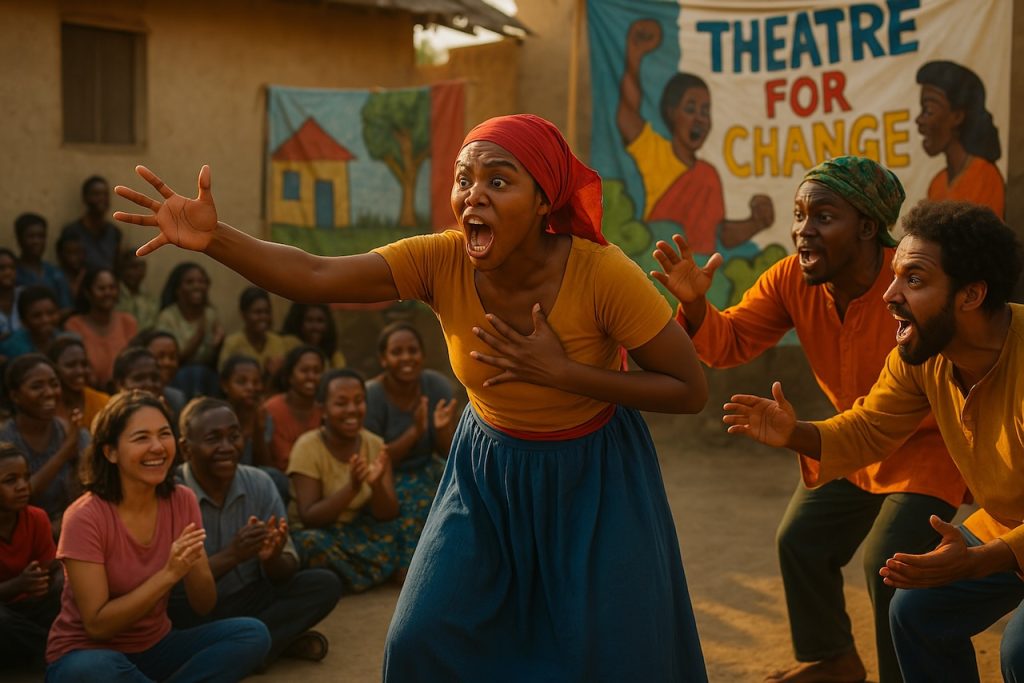First Place Winner and People’s Choice Winner 2025
| Submitted by: | Valentine Ukoh |
| Department: | Drama |
| Faculty: | Arts |
This image captures an open-air theatre performance unfolding in a rural community setting. The audience, composed of local residents seated on benches and the bare ground, is visibly engaged—some leaning forward, others responding with laughter and gestures. At the center, actors use minimal props and vivid expressions to dramatize a pressing community issue. This moment symbolizes the transformative power of theatre when rooted in familiar spaces, languages, and cultural practices. My research explores Theatre for Development (TfD) as a dynamic tool for communicating change and development. This image embodies how participatory theatre creates shared spaces for dialogue, awareness, and collective problem-solving—where community voices are not only heard, but activated toward meaningful social transformation.
Was your image created using Generative AI?
Yes.
Did you upload any materials into an AI tool to help generate your image?
No.
Which model of generative AI did you use?
DALL-E 2 by OpenAI.
How was your image created?
This image was generated using AI-powered digital art tools to visually represent a community-based Theatre for Development (TfD) performance. The process involved inputting a detailed prompt into an AI image generation model, specifying elements such as an outdoor rural setting, a small group of actors mid-performance, and a visibly engaged local audience. Attention was paid to body language, minimal props, and the emotional atmosphere to reflect the participatory and accessible nature of TfD. The composition draws from real-world TfD practices and cultural aesthetics typical of sub-Saharan Africa. While digitally created, the image was guided by ethnographic insight and theatrical staging conventions to convey the authenticity and power of theatre as a tool for grassroots communication, social awareness, and community-driven development. This creative method allowed for an illustrative depiction of core research themes that might otherwise be difficult to capture in a single candid photograph.
How did you craft your prompt to guide the generative AI in creating your image? Please describe the technique or approach you used to convey your vision to the AI.
My goal was to create a powerful visual representation of a Theatre for Development (TfD) performance in a rural African community setting. To guide the AI, I crafted a detailed prompt using clear keywords and scene descriptors such as “outdoor theatre performance,” “rural African village,” “community audience seated on benches and ground,” “actors performing with expressive gestures,” and “minimal stage props.” I emphasized a warm, natural lighting tone and cultural authenticity. After reviewing initial outputs, I refined the prompt to improve audience engagement and adjust actor positioning for more realistic interaction. Although I did not use advanced AI controls like negative prompts or custom aspect ratios, I made iterative adjustments to prompt clarity and tone to ensure the final image captured the participatory and empowering nature of TfD. The resulting image visually communicates the central theme of my research—using theatre as a catalyst for community dialogue and development.
Please describe what you uploaded to the AI tool, and confirm that the material is your original work, licensed for use (e.g., Creative Commons), used with proper permission.
I did not upload anything to AI. I only gave it a description of what I would like it to create based on the fact that my thesis centers around theatre for development. All I did was supplied a detailed description of the audience, colour, ambience I’d like it to create. That’s all. So, there’s no worry as to copyright infringement or whatever. The image is clean.
Where is the image located?
A digitally-created representation; inspired by typical community theatre settings in sub-Saharan Africa.

